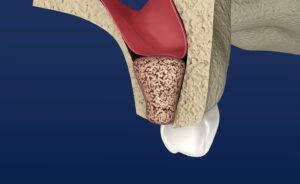 A dental implant is unique from any other tooth replacement method because it replicates both the root and the crown. Dental implants have over a 95% success rate; however, you must have a healthy jawbone to be a candidate for the procedure. It’s not uncommon to require bone grafting before your placement surgery because missing teeth cause your jaw to deteriorate. Although it’s common to need bone grafting, not everybody requires the additional procedure. If your implant dentist has recommended bone grafting, here’s why it’s necessary to ensure the success of your dental implant.
A dental implant is unique from any other tooth replacement method because it replicates both the root and the crown. Dental implants have over a 95% success rate; however, you must have a healthy jawbone to be a candidate for the procedure. It’s not uncommon to require bone grafting before your placement surgery because missing teeth cause your jaw to deteriorate. Although it’s common to need bone grafting, not everybody requires the additional procedure. If your implant dentist has recommended bone grafting, here’s why it’s necessary to ensure the success of your dental implant.
How Dental Implants Work
Traditional bridges and dentures only replace the portions of teeth above the gum line. A dental implant goes a step further. A titanium post is surgically placed into your jawbone to serve as a new tooth root. Your jaw must fuse to it through a process called osseointegration. After your bone has healed, you’ll have a second minor procedure to attach an abutment to the post. This special fixture will connect your restoration to your implant.
A Healthy Jawbone is Important
Your jaw must have sufficient bone density to support the implant. However, bone loss is a common complication of lost teeth. You can lose up to 25% of your jaw’s density within the first year of missing a tooth because it isn’t being stimulated by the root. It will continue to shrink over time. If you’ve experienced too much bone loss, your implant won’t have enough support, causing the procedure to fail. Bone grafting enhances the strength of your jaw to ensure it can support dental implants.
What to Expect with Bone Grafting
Your implant dentist will use bone from a donor or your own harvested bone to strengthen your jaw. Your gum tissue is opened to gain access to your jaw. The material is placed over the weakened area and your gums are sutured closed. Over the next several weeks, your jaw will heal to the graft, making you a suitable candidate for dental implants. Although it adds another step to your treatment plan, it is essential to ensure your dental implant succeeds.
Your implant dentist will determine if you require bone grafting after reviewing a CT scan of your oral structures. The highly detailed image rule allows them to see potential issues not visible from the surface. They may recommend additional procedures, like gum disease therapy or a sinus lift. After you’ve recovered from any preparatory procedures, you’ll be scheduled for your placement surgery. While replacing your lost tooth won’t happen overnight, it’s time well spent to benefit from the next best thing to your real teeth.
About Dr. Alexandra Kulwin
Dr. Kulwin achieved her dental degree at the Indiana University School of Dentistry and has continued her education in cosmetic dentistry, dental implants, and restorative dentistry. She is a proud member of the American Dental Association, the Cincinnati Dental Society, and the Ohio Dental Association. Request an appointment through her website or call her office at (513) 647-3001.
